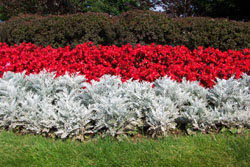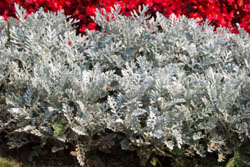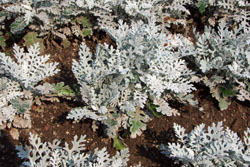






Perennial, Senecio Cineraria
Dusty Miller are an easy to grow perennial. Dusty Miller is grown for it's silvery-gray, fern-like foliage. Dusty Miller makes terrific border and edging plants, offering a striking contrast to the colorful flowers and green colors of your lawn and garden.
If allowed, the plants will produce flowers. Some gardeners pinch off the buds, as they are growing these plants strictly for the attractive foliage.
Plant Propagation:
Dusty Miller are grown from seed. They can be directly seeded into your flower garden, or started indoors for transplanting later. Or, sow Dusty Miller seeds outdoors, two to three weeks before the last frost in your area. In southern areas of the country, they can be directly seeded into your garden in the fall.
Start Dust Miller plants indoors, six to eight weeks before the last frost in your area, will give an early start for these showy plants.
Sow Dusty Miller seeds early in the season, covering lightly with soil. Final spacing for the plants is 10"-12" apart. They will tolerate a little crowding.

How to Grow Dusty Miller Plants:
Dusty Miller plants are very easy to grow. Once established, they will thrive for several years. Note, in some areas, Dusty Miller are often grown as annuals, in colder parts of the country.
Dusty Miller prefers a warm climate, full sun, and a rich, well drained soil. Mix in plenty of compost prior to the first planting. Add organic mulch each season to replenish the soil. Water them during dry periods, once or twice per week. Add a general purpose fertilizer once or twice a month.
Dusty Miller will grow tall, 10" - 18" tall. They will produce flowers. Many people remove them, or pinch back the buds to promote leaf growth.Trim plants as desired, to maintain an attractive shape.

Insect and Disease:
Dusty Miller are resistant to insects and disease. If insect or disease problems occur, treat early with organic or chemical insect repellents and fungicide.
Copyright © www.100flowers.win Botanic Garden All Rights Reserved